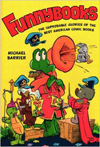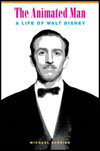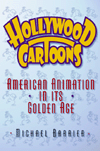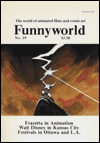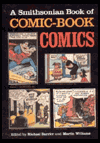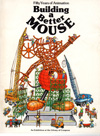
About
About MichaelBarrier.com
I began publishing Funnyworld magazine more than forty years ago as a vehicle for the kind of writing about animated films and comic art that I could find nowhere else:
- Critical writing that measured animated films, comic books, and comic strips against the high standards already set by the best filmmakers and cartoonists
- Consistently accurate historical articles and reporting on the most important current films
- Interviews in which important creators talked about their careers and explained how they had produced some of their best work
Funnyworld fulfilled that mission for more than ten years. Then, for a variety of reasons, I left it behind and concentrated my efforts on the research and writing for Hollywood Cartoons: American Animation in Its Golden Age, a critical history of Hollywood animation that was published in hardcover by Oxford University Press in 1999. (It was reissued as a trade paperback in October 2003.)
Much has changed since Funnyworld ceased publication, with both magazines and Web sites now offering coverage of animated films and comic art far beyond anything that I could have imagined in the seventies. As valuable as some of these new resources are, I don't see any real equivalent to Funnyworld in today's print and electronic marketplaces. Thus the rationale for this site: to scrutinize animated films and comic art through electronic means as I've done in the past in print.
Much of the content of MichaelBarrier.com is similar to that of Funnyworld:
- Commentary on current films, books, and comics
- Essays on a variety of animation- and comics-related subjects
- Interviews with leading creators
In addition, the site includes these pages:
- Capsules, brief essays on individual films
- Funnyworld Revisited, a selection of articles and reviews from the magazine
This site includes some actual animation, the "flip book" on the home page. Milton Gray contributed three such "flip books" to Hollywood Cartoons—here's what his demonstration of "rubber hose" animation should look like when you flip the corners of the book's pages.
About Michael Barrier
I have had two parallel careers. In one I was a journalist, a lawyer, and a political aide; in the other an independent scholar writing about animated films, comic books, and comic strips, especially those from the middle years of the twentieth century. At one point in my life, a typical day might find me spending my working hours analyzing important legislation for a U.S. senator and then lecturing in the evening at the National Archives on the animated films made during World War II. In later years, when I was traveling frequently as a senior editor of Nation’s Business, I often interviewed business people during the week and elderly cartoonists on weekends.
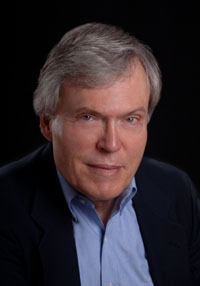 Like almost anyone else, I was first attracted to animation and the comics when I was a child. My interest was unusually intense—I published my own hectographed comic book for several years—and, to my surprise, I could not shed it after I reached adulthood. I finally stopped trying while I was a law student at the University of Chicago. I began seeking out the comic books drawn by former Disney cartoonists like Carl Barks and Walt Kelly. I also started paying close attention to animated cartoons again, and I found that the best of them repaid serious study just as the best silent comedies did. Nostalgia for childhood pleasures has vanished as a motive for my continuing fascination with animated films and the comics. In fact, I never even saw many of the films I most admire, or read many of the comic books and comic strips, until long after I was old enough to vote.
Like almost anyone else, I was first attracted to animation and the comics when I was a child. My interest was unusually intense—I published my own hectographed comic book for several years—and, to my surprise, I could not shed it after I reached adulthood. I finally stopped trying while I was a law student at the University of Chicago. I began seeking out the comic books drawn by former Disney cartoonists like Carl Barks and Walt Kelly. I also started paying close attention to animated cartoons again, and I found that the best of them repaid serious study just as the best silent comedies did. Nostalgia for childhood pleasures has vanished as a motive for my continuing fascination with animated films and the comics. In fact, I never even saw many of the films I most admire, or read many of the comic books and comic strips, until long after I was old enough to vote.
In 1970, after several years of writing for small-circulation publications, I began publishing a professionally printed magazine, Funnyworld, whose subtitle was "The World of Animated Films and Comic Art." The first serious publication of its kind, it achieved a circulation of several thousand copies and appeared on an irregular schedule for more than ten years. Thanks largely to Funnyworld—and through the good offices of the jazz critic Martin Williams, an admirer of the magazine—I signed a contract with Oxford University Press in 1973 to write a history of Hollywood animation. The research and writing of that book extended over twenty-four years.
To some extent, the book took so long to write because I had to combine work on it with full-time employment. (Writing history and criticism of comic books and animated films, especially Hollywood cartoons, has never been a plausible choice as a full-time career—even now, very few academics concentrate on such work—and it certainly wasn’t one thirty years ago.) Beyond that, I soon realized that if the book were to measure up to my own expectations for it, it was going to require a great deal more research than I originally planned, as well as more rigorous analysis of what I learned.
In the 1970s I not only published Funnyworld but also wrote about animation and the comics for other magazines. I was guest curator and author of the catalog for "Building a Better Mouse: Fifty Years of Animation," a 1978 exhibition at the Library of Congress that marked the golden anniversary of Walt Disney’s Steamboat Willie, the first Mickey Mouse cartoon to be released. In the early 1980s, I wrote one book—Carl Barks and the Art of the Comic Book, a biography and bibliography of the Disney comic-book artist—and co-edited another, A Smithsonian Book of Comic-Book Comics, with Martin Williams. Increasingly in the 1980s and 1990s, though, I declined such opportunities because they inevitably drained time from work on my animation history.
Hollywood Cartoons: American Animation in Its Golden Age was finally published in 1999. It does what I hoped it would do. It is an exceptionally accurate book, based overwhelmingly on primary sources (studio documents, court records, hundreds of interviews, and, of course, viewings of thousands of films). Just as important to me, the book adheres to a clear line of argument; the accurate facts are not there for their own sake. I don’t think it is possible to make a stronger case for the best of Hollywood animation—those films that have revealed the potential of the medium—than I have made in Hollywood Cartoons. The New York Times Book Review agreed: “Those who take the art of animation seriously will find this tough-minded book challenging and revelatory.”
Walt Disney is of course the dominant figure in Hollywood Cartoons, but the nature of that book was such that I could draw only an incomplete portrait of the man. In my new book, The Animated Man: A Life of Walt Disney, I have depicted Disney at full length and given overdue attention to his whole career as a filmmaker. As I say in my Preface, “It is his animated films of the 1930s and early 1940s that make him uniquely interesting,” but by the same token, those films are so extraordinary that they make everything else he did of absorbing interest. The Animated Man thus examines Disney’s live-action films more carefully than earlier biographies, and it explains how his transformation of the amusement park, through Disneyland, grew out of his triumphs and frustrations as a filmmaker.
In writing The Animated Man, I have relied not just on months of research in the Walt Disney Archives—I visited there often during my work on Hollywood Cartoons—but on research at dozens of other libraries and archives. I’ve also drawn upon extensive interviews I recorded with more than 150 of Disney’s employees and associates beginning in 1969, two and a half years after his death. Most of the people I interviewed are now deceased; no other biography has ever been, or ever can be, based upon so rich a trove of personal memories.
Karal Ann Marling, curator of the landmark exhibition “The Architecture of Reassurance: Designing Disney’s Theme Parks,” has said of The Animated Man: “Barrier shows us a tireless innovator, a man of deep feeling, a true American original who has woven himself into the very fabric of modern culture.” That was the real Walt Disney, the man that readers will encounter in my book.
[Revised version posted February 18, 2007; new photo posted August 27, 2007.]
Quick Links
New to the site? Click here to go to a page that explains what it's all about.
To comment on anything on the site, write to me at the following address: michaelbarrier@comcast.net. I’ll assume that your comments are intended for publication unless you specify otherwise.
